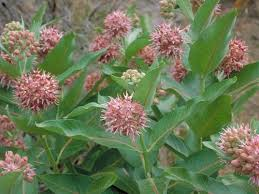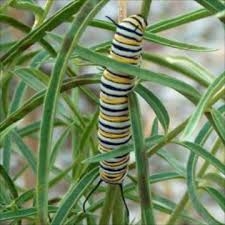
Monarch butterflies are declining rapidly in number, along with the native milkweed plants that they depend on from Canada through much of the U.S. Experts attribute the decline to the expansion of cities and suburbs,morelawn mowing, more herbicide use and more intensive farming practices. The drought hasn't helped.
California boasts 15 native species of milkweed; most are drought tolerant. These plants are the primary food of Monarch larvae.Milkweeds also support a large range of pollinators, such as bees and hummingbirds.
Milkweeds are named for their milky sap, a sticky latex that oozes out when the plant is cut. The plant tissues contain cardenolides, a type of steroid. Monarch caterpillars eat the plants, which then protects them by making them distasteful to predators.
Most livestock avoid milkweed unless they are very hungry or unless it is accidentally mixed in with hay or feed. Milkweed tastes bitter and all parts of the plant are considered toxic to most mammals. Use gloves or wash your hands after touching the plant and avoid touching your eyes.
Native Americans used fibers from the milkweed stem to weave cloth and make cords and ropes. They treated ringworm and bee stings with the sap and made an extract from the leaves for curing coughs, relieving lung inflammation and stimulating lymphatic drainage.
The seed pods contain a fair amount of floss that carries the seeds on the wind. Today the floss is used as a hypoallergenic filling for pillows and comforters.
Milkweeds typically flower between late spring and the end of summer. After they disperse their seed, the above-ground growth dies back, readying for winter. My milkweed had a little stub above ground throughout winter. This last spring and summer, it shot up to about three feet with good space between the narrow green leaves. In mid to late summer, the colorful blooms attracted one lonely Monarch that seemed to keep circling back to feed and rest over many days.
I adopted this plant without knowing what type of milkweed it was. I was told it was hardy and drought tolerant and to leave it alone after planting. I was instructed to water it for a few weeks and then very little once established.
Newly planted seedlings produce leaves the first year; in the second year, you get flowers. Once I saw the orange, red and yellow blooms, I looked up what kind of milkweed I had. To my horror, I learned that it was a tropical milkweed bloodflower (Asclepiascurassavica), also known as butterfly Asclepias ‘Bright Wings'.
This milkweed is not native north of Mexico. Unfortunately, due to its showy flowers, multiple bloom periods and ability to attract egg-laying Monarchs, it has been widely planted.
Scientists are concerned that this non-native milkweed, unlike North American milkweeds, will have foliage year-round when grown in areas with mild winters and adequate moisture. This persistent foliage might encourage Monarchs to lay eggs outside of their regular breeding season or to linger in areas longer than they normally would and to risk freezing. The year-round presence of milkweed is also associated with higher parasitism rates in Monarchs, lowering the survival rate.
My tropical milkweed has produced many seed pods. I remove them before they pop open to prevent reseeding. I recently tried finding some native milkweed in nurseries to replace mine, but they were sold out. Mail-order sources had milkweeds, but they looked too much like mine.
This spring I will plant seeds of showy milkweed (Asclepias speciosa, which grows up to five feet) and narrow-leaved milkweed (Asclepiasfascicularis, which reaches three feet) or get seedlings at the nursery. The California Native Plant Society recommends these species for Napa Valley.
My Monarch moved on by October 10. I was going to remove the tropical milkweed, but on close inspection, I noticed four healthy, good-sized Monarch caterpillars and a number of tiny ones chomping away. I hope some will make it to the coast as butterflies before winter. Then I will uproot the tropical milkweed.
For more information on native milkweeds and Monarch butterflies, consult the website of the Xerces Society for Invertebrate Conservation or the California Native Plant Society.
Workshop: U. C. Master Gardeners of Napa County will hold a workshop on “Fruit Tree Selection and Planting” on Sunday, November 15, from 2 p.m. to 4 p.m. at Yountville Community Center, 6516 Washington Street, Yountville. Get ready to plant bare-root fruit trees or to transplant from a pot into the ground. You will learn about soil types, site selection and preparation, and first-year care so that your new fruit trees thrive. The second half of this workshop will help you decide what trees to plant. Topics include disease resistance, rootstock influence, climate and chill hours, and specific varieties that perform well in various parts of Napa County. To register, call 707-944-8712 or visit the Parks and Recreation web site.
Master Gardeners are volunteers who help the University of California reach the gardening public with home gardening information. U. C. Master Gardeners of Napa County ( http://ucanr.org/ucmgnapa/) are available to answer gardening questions in person or by phone, Monday, Wednesday and Friday, 9 a.m. to Noon, at the U. C. Cooperative Extension office, 1710 Soscol Avenue, Suite 4, Napa, 707-253-4143, or from outside City of Napa toll-free at 877-279-3065. Or e-mail your garden questions by following the guidelines on our web site. Click on Napa, then on Have Garden Questions? Find us on Facebook under UC Master Gardeners of Napa County.
Attached Images:
